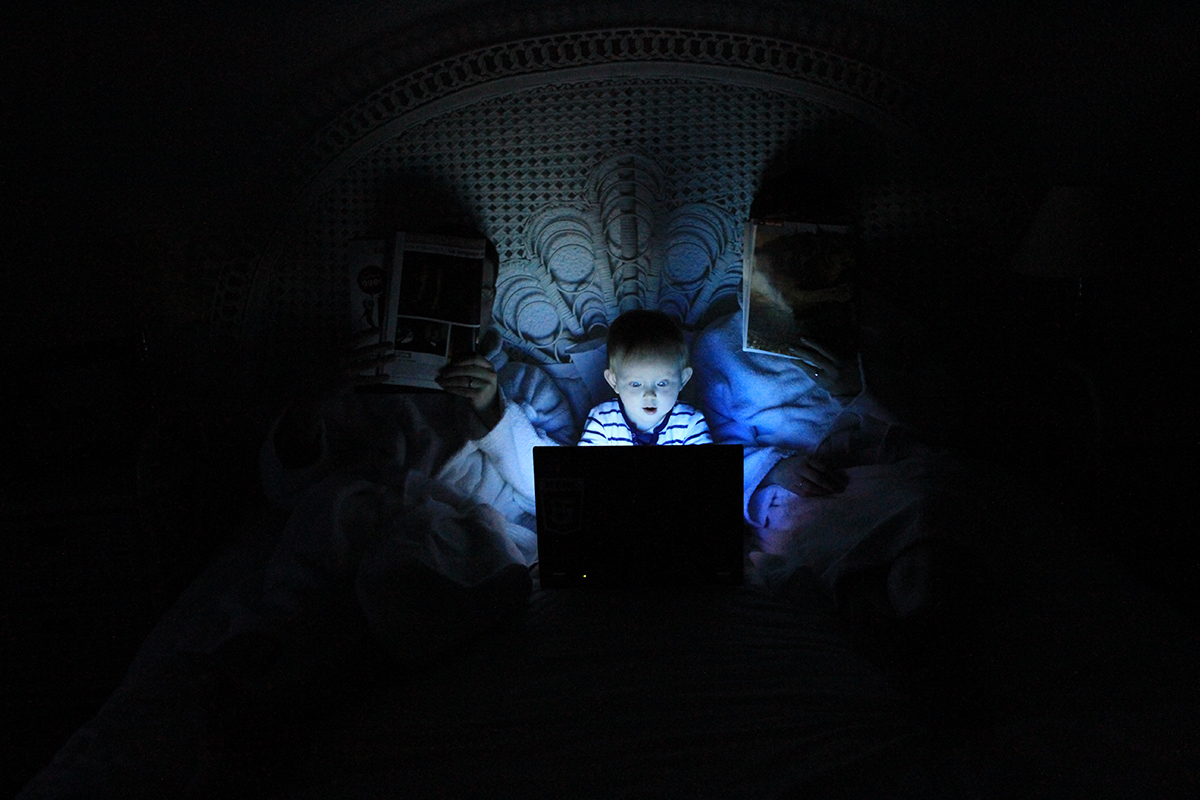Digital Screens Wreak Havoc on the Eyes: Prevent Damage to Your and Your Child’s Vision

By Kimberly Blaker
As parents can attest, the amount of time kids spend plugged in can be a real problem. There are plenty of good reasons for parents’ concern. But it isn’t just that it’s sedentary, isolating and decreases their attention spans. Digital screens also cause eye damage and vision problem.
One of these problems, computer vision syndrome, is also known as digital eye strain. More concerning, however, is the permanent damage blue light causes to the eyes. But kids aren’t the only ones affected. Adults’ eyes are affected by digital screens as well.
Digital Eye Strain
Computer vision syndrome causes vision problems and eye discomfort. As the American Optometric Association explains, it results from extended viewing of computer screens, e-readers, tablets, and cell phones, The more time spent on digital devices, the worse the discomfort becomes.
According to The Vision Council, computer vision syndrome symptoms include eyestrain, dry eyes, headache, blurred vision, and neck and shoulder pain.
Fortunately, there are several solutions to prevent or cure computer vision syndrome. First, set limits on daily leisure media use for yourself and your child. Because of the numerous adverse effects of media consumption, the American Academy of Pediatrics announced recommendations in 2016 for children’s media use.
For children under 18 months, limit screen media exclusively to video chatting.
From 18 to 24 months, look for high-quality programming. Although the APA doesn’t specify an amount of time for this age group, less than one hour a day can be presumed based on the next age group.
For ages two to five years, allow no more than one hour a day of media.
Kids ages six and older should have consistent limits for their total media time and specific restrictions on various media types. In recognizing each family and child is different, the APA hasn’t set a standard amount of time for this age group. But outside of family media activities and homework, kids should spend only a small percentage of their day plugged in.
Another way to protect against computer vision syndrome is to wear computer eyeglasses. If you or your child experience digital eye strain symptoms, make an appointment with an optometrist for a vision check. Be sure to discuss screen use to determine if computer glasses might be the right choice.
Also, when using a computer, position the screen at an arm’s distance away. Increase the font size to reduce strain as well. You can also reduce overhead lighting to eliminate glare.
Finally, follow the easy-to-remember 20-20-20 rule that’s recommended by the AOA. Every 20 minutes, take a 20-second screen break by looking at something 20 feet away.
Blue Light Hazards
In addition to computer vision syndrome, exposure to blue light is another digital screen hazard. Blue light comes from many sources. This includes and comes primarily from sunlight as well as LED and fluorescent lighting. But smartphones, flat-screen TVs, computers and electronic notebooks also emit significant amounts of blue light.
The problem is that our eyes can’t block blue light. So it penetrates the eye lens and cornea, then it reaches the retina. Prolonged exposure to blue light is likely a contributor to macular degeneration and vision loss.
But our eyes aren’t the only thing impacted by blue light. Harvard researchers found that blue light affects our circadian rhythm and throws off the body’s biological clock. The Harvard Health Letter reported, “Blue light has a dark side,” literally. Night-time light exposure appears to particularly unhealthy. Numerous studies have linked exposure to light at night (while working the night shift) with breast and prostate cancer, heart disease, diabetes and obesity.
Harvard researchers also point out that even dim light affects our circadian rhythm and interferes with melatonin secretion. The lack of sleep that results from it then increases the risk of depression. So there are multiple good reasons to try to reduce blue light exposure.
Minimizing screen time is one of the most obvious ways to reduce exposure.
Also, shut down devices with digital screens two to three hours before bed, if possible. If not, at least dim the screen light in the evenings.
If your child requires a nightlight, use a dim red light instead. This has the least impact on the circadian rhythm and eyes.
Finally, if you or your child spend much time on digital devices, stay up late, or work the night shift, wear blue-blocking glasses. This will also reduce the likelihood of eye damage or throwing your circadian rhythm out of balance.









